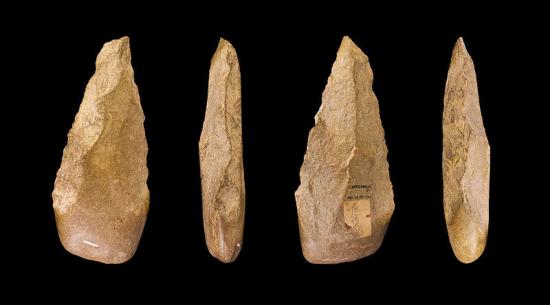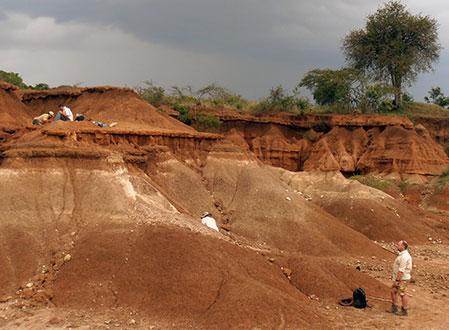Researchers at the University of Liverpool have found that long and slender stone tools were made by human ancestors at least a million years ago - nearly twice as long ago as generally thought.
Source - http://www.pasthorizonspr.com/index.php/archives/10/2013/elongation-in-acheulean-handaxes-a-matter-of-choice

Pointed trachyte biface tool photographed at Kilombe. Image: University of Liverpool
Materials such as branches, twigs, and stems were readily available to both animal and human tool makers from millions of years ago, but research at Liverpool has now shown that elongate forms were also made out of stone by human ancestors much earlier than is usually recognised.
Professor John Gowlett, as a member of an international team based on the Universityâs Department of Archaeology, Classics and Egyptology, is working at Kilombe in Kenya, where he has found a number of hand axe tools that are very long and narrow.

Acheulean axe dated to between 500,000 and 300,000 BP. Image Wikimedia
Professor Gowlett said: “Psychologists have shown that moderately elongate forms are often favoured, especially those in the ratio 0.61. But there also seems to be a special attraction to far longer and slenderer forms.
“Some of the stone tools from Kilombe and other early sites are almost two and a half times as long as broad and there is no way this can occur by accident. They must have been carefully crafted.
“Usually such slender shapes are found far later in the fine blade tools made by Homo sapiens. The hand-axes were made by the earlier Homo erectus.
“As the concentrations of elongate tools are rare on the Kilombe site, they were probably made to carry out tasks of animal butchery or plant preparation which did not occur very often.
“They show that when the need arose early humans were capable of strikingly sophisticated behaviour.”

Professor John Gowlett and his team made the discovery at this site in Kilombe, Kenya Image: University of Liverpool
Source: University of Liverpool
More Information
J. A. J. Gowlett Research article: Elongation as a factor in artefacts of humans and other animals: an Acheulean example in comparative context Phil. Trans. R. Soc. B. 2013 368 1630 20130114; doi:10.1098/rstb.2013.0114 (published 7 October 2013) 1471-2970
Dora Biro, Michael Haslam, and Christian Rutz Introduction: Tool use as adaptation Phil. Trans. R. Soc. B. 2013 368 1630 20120408; doi:10.1098/rstb.2012.0408 (published 7 October 2013) 1471-2970 Open Access
Gowlett, J.A.J. (2006). The elements of design form in Acheulian bifaces: modes, modalities, rules and language. In: Goren-Inbar, N. and G. Sharon (eds) Axe Age: Acheulian Tool-making from Quarry to Discard. Equinox, London.
R.H. Crompton, J.A.J. Gowlett, Allometry and multidimensional form in Acheulean bifaces from Kilombe, Kenya Journal of Human Evolution, Volume 25, Issue 3, September 1993, Pages 175-199